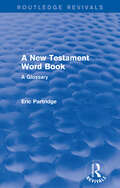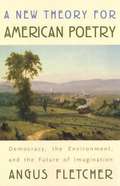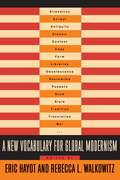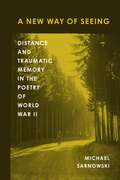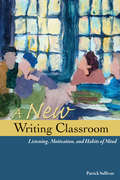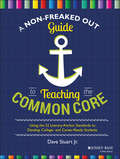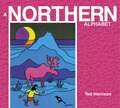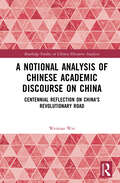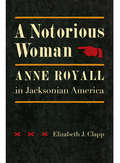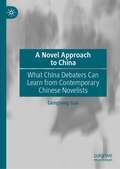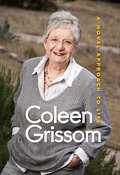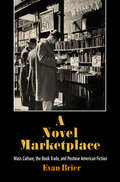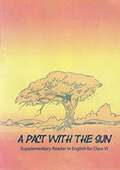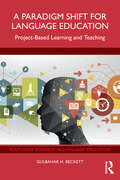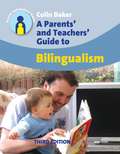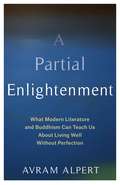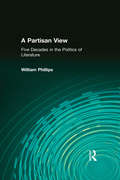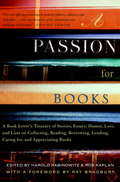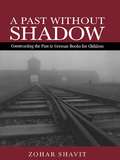- Table View
- List View
A New Testament Word Book: A Glossary (Routledge Revivals: The Selected Works of Eric Partridge)
by Eric PartridgeFirst published in 1940, this book provides a literary dictionary to the New Testament. The treatment of selected words and phrases is not theological, but lexicographical and etymological. Each entry is introduced by illustrative quotations from the New Testament, and the book provides an insightful exploration of these phrases.
A New Theory for American Poetry: Democracy, the Environment, and the Future of Imagination
by Angus FletcherAmid gloomy forecasts of the decline of the humanities and the death of poetry, Angus Fletcher, a wise and dedicated literary voice, sounds a note of powerful, tempered optimism. He lays out a fresh approach to American poetry at large, the first in several decades, expounding a defense of the art that will resonate well into the new century. Breaking with the tired habit of treating American poets as the happy or rebellious children of European romanticism, Fletcher uncovers a distinct lineage for American poetry. His point of departure is the fascinating English writer, John Clare; he then centers on the radically American vision expressed by Emerson and Walt Whitman. With Whitman this book insists that "the whole theory and nature of poetry" needs inspiration from science if it is to achieve a truly democratic vista. Drawing variously on Complexity Theory and on fundamentals of art and grammar, Fletcher argues that our finest poetry is nature-based, environmentally shaped, and descriptive in aim, enabling poets like John Ashbery and other contemporaries to discover a mysterious pragmatism. Intense, resonant, and deeply literary, this account of an American poetics shows how today's consumerist and conformist culture subverts the imagination of a free people. While centering on American vision, the argument extends our horizon, striking a blow against all economically sanctioned attacks upon the finer, stronger human capacities. Poetry, the author maintains, is central to any coherent vision of life.
A New Vocabulary for Global Modernism
by Eric Hayot Rebecca L. WalkowitzBringing together leading critics and literary scholars, A New Vocabulary for Global Modernism argues for new ways of understanding the nature and development of twentieth-century literature and culture. Scholars have largely understood modernism as an American and European phenomenon. Those parameters have expanded in recent decades, but the incorporation of multiple origins and influences has often been tied to older conceptual frameworks that make it difficult to think of modernism globally. Providing alternative approaches, A New Vocabulary for Global Modernism introduces pathways through global archives and new frameworks that offer a richer, more representative set of concepts for the analysis of literary and cultural works.In separate essays each inspired by a critical term, this collection explores what happens to the foundational concepts of modernism and the methods we bring to modernist studies when we approach the field as a global phenomenon. Their work transforms the intellectual paradigms we have long associated with modernism, such as tradition, antiquity, style, and translation. New paradigms, such as context, slum, copy, pantomime, and puppets emerge as the archive extends beyond its European center. In bringing together and reexamining the familiar as well as the emergent, the contributors to this volume offer an invaluable and original approach to studying the intersection of world literature and modernist studies.
A New Vocabulary for Global Modernism (Modernist Latitudes)
by Eric Hayot Rebecca L. WalkowitzBringing together leading critics and literary scholars, A New Vocabulary for Global Modernism argues for new ways of understanding the nature and development of twentieth-century literature and culture. Scholars have largely understood modernism as an American and European phenomenon. Those parameters have expanded in recent decades, but the incorporation of multiple origins and influences has often been tied to older conceptual frameworks that make it difficult to think of modernism globally. Providing alternative approaches, A New Vocabulary for Global Modernism introduces pathways through global archives and new frameworks that offer a richer, more representative set of concepts for the analysis of literary and cultural works.In separate essays each inspired by a critical term, this collection explores what happens to the foundational concepts of modernism and the methods we bring to modernist studies when we approach the field as a global phenomenon. Their work transforms the intellectual paradigms we have long associated with modernism, such as tradition, antiquity, style, and translation. New paradigms, such as context, slum, copy, pantomime, and puppets emerge as the archive extends beyond its European center. In bringing together and reexamining the familiar as well as the emergent, the contributors to this volume offer an invaluable and original approach to studying the intersection of world literature and modernist studies.
A New Way of Seeing: Distance and Traumatic Memory in the Poetry of World War II (American Wars and Popular Culture)
by Michael SarnowskiA New Way of Seeing considers the poetry of five writers—Louis Simpson, Keith Douglas, Richard Hugo, Howard Nemerov, and Randall Jarrell—whose work draws on their activities as soldiers in World War II. Basing his examination on extensive primary-source research, Michael Sarnowski identifies distance, both literal and figurative, and traumatic memory as two interconnected elements of how these poets internalized the war and made sense of the events they witnessed. The book is structured on a gradient related to each poet’s proximity to combat, as the chapters in turn focus on an infantryman (Simpson), a tank commander (Douglas), a bombardier (Hugo), a pilot (Nemerov), and a stateside flight instructor (Jarrell). Sarnowski relies on a wealth of archival material overlooked by previous scholarship, including poem drafts, correspondence, flight logs, and personal belongings. The conclusion revisits notions of legacy and representation by assessing factors that contributed to the early labeling of World War II soldiers as a “Silent Generation,” in contrast to the outpouring of poetry published during and following the First World War. By exploring how poets processed their wartime experiences, A New Way of Seeing offers a stark reminder of why it remains vital to recognize the physical, mental, and psychological consequences endured by veterans.
A New Writing Classroom
by Patrick SullivanIn A New Writing Classroom, Patrick Sullivan provides a new generation of teachers a means and a rationale to reconceive their approach to teaching writing, calling into question the discipline's dependence on argument.Including secondary writing teachers within his purview, Sullivan advocates a more diverse, exploratory, and flexible approach to writing activities in grades six through thirteen. A New Writing Classroom encourages teachers to pay more attention to research in learning theory, transfer of learning, international models for nurturing excellence in the classroom, and recent work in listening to teach students the sort of dialogic stance that leads to higher-order thinking and more sophisticated communication.The conventional argumentative essay is often a simplistic form of argument, widely believed to be the most appropriate type of writing in English classes, but other kinds of writing may be more valuable to students and offer more important kinds of cognitive challenges. Focusing on listening and dispositions or "habits of mind" as central elements of this new composition pedagogy, A New Writing Classroom draws not just on composition studies but also on cognitive psychology, philosophy, learning theory, literature, and history, making an exciting and significant contribution to the field.
A New Writing Classroom: Listening, Motivation, and Habits of Mind
by Patrick SullivanIn A New Writing Classroom, Patrick Sullivan provides a new generation of teachers a means and a rationale to reconceive their approach to teaching writing, calling into question the discipline's dependence on argument. Including secondary writing teachers within his purview, Sullivan advocates a more diverse, exploratory, and flexible approach to writing activities in grades six through thirteen. A New Writing Classroom encourages teachers to pay more attention to research in learning theory, transfer of learning, international models for nurturing excellence in the classroom, and recent work in listening to teach students the sort of dialogic stance that leads to higher-order thinking and more sophisticated communication. The conventional argumentative essay is often a simplistic form of argument, widely believed to be the most appropriate type of writing in English classes, but other kinds of writing may be more valuable to students and offer more important kinds of cognitive challenges. Focusing on listening and dispositions or "habits of mind” as central elements of this new composition pedagogy, A New Writing Classroom draws not just on composition studies but also on cognitive psychology, philosophy, learning theory, literature, and history, making an exciting and significant contribution to the field.
A Non-Freaked Out Guide to Teaching the Common Core
by Dave Stuart Jr.Implement the Common Core for ELA without all the stress A Non-Freaked Out Guide to Teaching the Common Core uses the often-neglected anchor standards to get to the heart of the Common Core State Standards (CCSS)--teaching students the skills they need to be college and career ready. Each anchor standard is broken down into its key points, and a discussion of each anchor standard's central purpose helps outline the context for each required skill. This easy-to-read guide gives educators the kind of clear explanations, examples, and strategies they need to feel comfortable teaching the CCSS, and shows how CCSS skills can be integrated into virtually any existing lesson plan. Getting a firm grasp of the anchor standards is the quickest way to start teaching the key concepts of the CCSS, and this user-friendly guide is designed to pave the way for both the first-time teacher and the experienced pro.
A Northern Alphabet (ABC Our Country)
by Ted HarrisonA is for Arctic, B for Bering Sea, C for Clyde River – and Z for Zangeza Bay – all to be explored above the 60th parallel.
A Notional Analysis of Chinese Academic Discourse on China: Centennial Reflection on China’s Revolutionary Road (Routledge Studies in Chinese Discourse Analysis)
by Weixiao WeiNotional Analysis of Chinese Academic Discourse on China presents an executive summary of Chinese academic discourse about China’s progress and achievements in the past one hundred years. Using a scientometric method to analyze bibliographic records retrieved from the largest library database in China on aspects of Chinese Studies, this book offers an insider’s view regarding social, cultural, historical and political aspects of China that have never been systematically published in English before. This book first follows a quantitative approach using bibliometric analysis to identify keywords in the Chinese academic works about China in conceptual clusters for the past hundred years. Then a qualitative method is adopted to select significant and representative discourses within each conceptual cluster. By helping to establish two-way communication and facilitate mutual understanding, this book holds great potential for helping to resolve conflict and promoting peace. This book offers an eye-opening experience for anyone studying or researching Chinese Studies, including related subjects such as Chinese language, culture and education, or a broader subject within global politics, economy, sociology and culture, which acknowledges China as a major player in the field.
A Notorious Woman: Anne Royall in Jacksonian America
by Elizabeth J. ClappDuring her long career as a public figure in Jacksonian America, Anne Royall was called everything from an "enemy of religion" to a "Jackson man" to a "common scold. " In her search for the source of such strong reactions, Elizabeth Clapp has uncovered the story of a widely read woman of letters who asserted her right to a political voice without regard to her gender. Widowed and in need of a livelihood following a disastrous lawsuit over her husband’s will, Royall decided to earn her living through writing--first as a travel writer, journeying through America to research and sell her books, and later as a journalist and editor. Her language and forcefully expressed opinions provoked people at least as much as did her inflammatory behavior and aggressive marketing tactics. An ardent defender of American liberties, she attacked the agents of evangelical revivals, the Bank of the United States, and corruption in government. Her positions were frequently extreme, directly challenging the would-be shapers of the early republic’s religious and political culture. She made many enemies, but because she also attracted many supporters, she was not easily silenced. The definitive account of a passionate voice when America was inventing itself, A Notorious Woman re-creates a fascinating stage on which women’s roles, evangelical hegemony, and political involvement were all contested.
A Novel Approach to China: What China Debaters Can Learn from Contemporary Chinese Novelists
by Gengsong GaoThis book explores Chinese novelists’ distinctive contributions to the China debate in terms of the key issues of Chinese language, power dynamics and Confucian tradition. As China is rising, Chinese scholars and policymakers are debating heatedly over China’s past, present and future. Who are the major debaters? How do they analyze China’s problems and figure out solutions? What are the main achievements and weaknesses of the Chinese intellectual debate and discourse? Chinese novelists also get involved in the China debate. However, their voices are rarely heard. This book argues that, by dramatizing the diversities of ordinary social actors’ everyday languages, active discursive practices and enchanted local traditions, Chinese novelists do not merely illustrate the dominant liberal, the New Left and the New Confucian ideologies, but enrich the China debate and provide a “novel” approach to our understanding of modern China.
A Novel Approach to Life
by Coleen GrissomAs an administrator and teacher at San Antonio's Trinity University for five decades, Coleen Grissom saw the rise of feminism, the sexual revolution, and the tragic deaths of students, friends, and family. This varied collection assembles the best of her speeches probing these and other timely issues, from drug use and freedom of speech to AIDS and racism. More than the sum of its parts, this book, filigreed with pithy literary insights, offers an astute chronicle of its times that gives readers good reasons to embrace literature and life.
A Novel Approach to Life
by Coleen GrissomAs an administrator and teacher at San Antonio's Trinity University for five decades, Coleen Grissom saw the rise of feminism, the sexual revolution, and the tragic deaths of students, friends, and family. This varied collection assembles the best of her speeches probing these and other timely issues, from drug use and freedom of speech to AIDS and racism. More than the sum of its parts, this book, filigreed with pithy literary insights, offers an astute chronicle of its times that gives readers good reasons to embrace literature and life.
A Novel Marketplace: Mass Culture, the Book Trade, and Postwar American Fiction
by Evan BrierAs television transformed American culture in the 1950s, critics feared the influence of this newly pervasive mass medium on the nation's literature. While many studies have addressed the rhetorical response of artists and intellectuals to mid-twentieth-century mass culture, the relationship between the emergence of this culture and the production of novels has gone largely unexamined.In A Novel Marketplace, Evan Brier illuminates the complex ties between postwar mass culture and the making, marketing, and reception of American fiction. Between 1948, when television began its ascendancy, and 1959, when Random House became a publicly owned corporation, the way American novels were produced and distributed changed considerably. Analyzing a range of mid-century novels—including Paul Bowles's The Sheltering Sky, Ray Bradbury's Fahrenheit 451, Sloan Wilson's The Man in the Gray Flannel Suit, and Grace Metalious's Peyton Place—Brier reveals the specific strategies used to carve out cultural and economic space for the American novel just as it seemed most under threat. During this anxious historical moment, the book business underwent an improbable expansion, by capitalizing on an economic boom and a rising population of educated consumers and by forming institutional alliances with educators and cold warriors to promote reading as both a cultural and political good.A Novel Marketplace tells how the book trade and the novelists themselves successfully positioned their works as embattled holdouts against an oppressive mass culture, even as publishers formed partnerships with mass-culture institutions that foreshadowed the multimedia mergers to come in the 1960s. As a foil for and a partner to literary institutions, mass media corporations assisted in fostering the novel's development as both culture and commodity.
A Pact with the Sun: Supplementary Reader class 6 - NCERT - 23
by National Council of Educational Research and Training"A Pact with the Sun" is an engaging supplementary reader in English for Class VI by NCERT, presenting a collection of heartwarming stories that explore various themes and emotions. This anthology introduces young readers to narratives filled with moral lessons, human values, and insightful experiences. The book comprises stories that range from a boy's encounter with a genie to tales of friendship, bravery, and compassion. Each story is crafted to captivate the imagination of students while instilling important life lessons. Through relatable characters and diverse situations, the book encourages readers to reflect on the significance of integrity, honesty, empathy, and perseverance. The anthology serves as a catalyst for nurturing young minds, fostering their moral development, and promoting critical thinking by delving into the complexities of human nature and relationships. Overall, "A Pact with the Sun" stands as a compelling resource that combines entertainment with valuable lessons, making it an enriching read for students.
A Paradigm Shift for Language Education: Project-Based Learning and Teaching (Routledge Research in Language Education)
by Gulbahar H. BeckettThis book investigates the argument for the significance and necessity of project-based learning and teaching (PBLT), as it becomes increasingly important in language education.Drawing on research and professional literature spanning over 100 years, it explores the research foundations and the historical and theoretical antecedents of PBLT, articulating the application of PBLT as a valuable approach for second language education pedagogy and research. Utilizing qualitative classroom research conducted in Canada, it then moves to address key concerns surrounding the difficulties of effectively implementing PBLT with existing curriculum and keeping track of content acquisition, cognitive and social skills development, and language learning.Authoritatively written, and offering fresh insight into how the field can be advanced by engaging second language (L2) students in deeper learning and higher order thinking with 21st-century PBLT contextually, situationally, and multimodally, it makes a valuable pedagogical and research contribution that benefits practitioners and researchers in the field. As such, it will appeal to researchers, faculty, and L2 professionals with interests in L2 education, multimodal teaching and learning, and applied linguistics.
A Parents' and Teachers' Guide to Bilingualism
by Colin BakerIn this accessible guide to bilingualism in the family and the classroom, Colin Baker delivers a realistic picture of the joys and difficulties of raising bilingual children. The Q&A format of this book makes it the natural choice for the busy parent or teacher who needs an easy reference guide to the most frequently asked questions. This revised edition includes more information on bilingualism in the digital age, and incorporates the latest research in areas such as neonatal language experience, multilingualism, language mixing and the effect that siblings have on family language choice.
A Partial Enlightenment: What Modern Literature and Buddhism Can Teach Us About Living Well Without Perfection
by Avram AlpertIn many ways, Buddhism has become the global religion of the modern world. For its contemporary followers, the ideal of enlightenment promises inner peace and worldly harmony. And whereas other philosophies feel abstract and disembodied, Buddhism offers meditation as a means to realize this ideal. If we could all be as enlightened as Buddhists, some imagine, we could live in a much better world. For some time now, however, this beatific image of Buddhism has been under attack. Scholars and practitioners have criticized it as a Western fantasy that has nothing to do with the actual experiences of Buddhists.Avram Alpert combines personal experience and readings of modern novels to offer another way to understand modern Buddhism. He argues that it represents a rich resource not for attaining perfection but rather for finding meaning and purpose in a chaotic world. Finding unexpected affinities across world literature—Rudyard Kipling in colonial India, Yukio Mishima in postwar Japan, Bessie Head escaping apartheid South Africa—as well as in his own experiences living with Tibetan exiles, Alpert shows how these stories illuminate a world in which suffering is inevitable and total enlightenment is impossible. Yet they also give us access to partial enlightenments: powerful insights that become available when we come to terms with imperfection and stop looking for wholeness. A Partial Enlightenment reveals the moments of personal and social transformation that the inventions of modern Buddhism help make possible.
A Partisan View: Five Decades in the Politics of Literature
by William PhillipsSince its founding in 1937, "Partisan Review" has been one of the most important and culturally influential journals in America. Under the legendary editorship of William Phillips and Philip Rahv, "Partisan Review" began as a publication of the John Reed Club, but soon broke away to establish itself as a free voice of critical dissent. As such, it counteracted the inroads of cultural Stalinism and took up the fight for aesthetic modernism at a time when the latter was fiercely contested by both the political left and right. In this work, William Phillips offers an account of his own part in the magazine's eventful history. As the magazine's editor, Edith Kurzweil, notes in her introduction, many of the literary and political disagreements that famously marked "Partisan Review"'s history originated in the editors' initial adherence to a programme of radical politics and avant-gardism. Although this proved increasingly unworkable, Phillips and Rahv, even from the outset, never allowed sectarian narrowness to determine the magazine's contents. Over the decades, "Partisan Review" published work by authors as far from radicalism as T.S. Eliot and Wallace Stevens or from Marxist orthodoxy as Albert Camus and George Orwell. In literature, its contributors were as stylistically and intellectually varied as Saul Bellow, Vladimir Nabokov, Robert Lowell and Isaac Bashevis Singer. In short, "Partisan Review" featured the best fiction, poetry and essays of the 1940s and postwar decades. Beyond its literary preeminence, Partisan Review was famed as the most representative journal of the New York Intellectuals.
A Passage to India (MAXNotes Literature Guides)
by Ann WoodREA's MAXnotes for E. M. Forster's A Passage to India MAXnotes offer a fresh look at masterpieces of literature, presented in a lively and interesting fashion. Written by literary experts who currently teach the subject, MAXnotes will enhance your understanding and enjoyment of the work. MAXnotes are designed to stimulate independent thought about the literary work by raising various issues and thought-provoking ideas and questions. MAXnotes cover the essentials of what one should know about each work, including an overall summary, character lists, an explanation and discussion of the plot, the work's historical context, illustrations to convey the mood of the work, and a biography of the author. Each chapter is individually summarized and analyzed, and has study questions and answers.
A Passage to India (SparkNotes Literature Guide Series)
by SparkNotesA Passage to India (SparkNotes Literature Guide) by E. M. Forster Making the reading experience fun! Created by Harvard students for students everywhere, SparkNotes is a new breed of study guide: smarter, better, faster. Geared to what today's students need to know, SparkNotes provides: *Chapter-by-chapter analysis *Explanations of key themes, motifs, and symbols *A review quiz and essay topicsLively and accessible, these guides are perfect for late-night studying and writing papers
A Passion for Books: A Book Lover's Treasury of Stories, Essays, Humor, Lore, and Lists on Collecting , Reading, Borrowing, Lending, Caring for, and Appreciating Books
by Rob Kaplan Harold RabinowitzTwo publishing industry veterans collect 60 classic and modern musings on the joys and perils of bibliomania. They include book care tips, resources, "The Ten Best-Selling Books Rejected by Publishers Twenty Times or More," cartoons, a bibliobibliography, and a foreword by Ray Bradbury who wrote of book-burning in . Annotation c. Book News, Inc. , Portland, OR (booknews. com)
A Past Without Shadow: Constructing the Past in German Books for Children (Children's Literature and Culture #Vol. 32)
by Zohar ShavitA Past Without Shadow examines 50 years of German children's books in which the darkest horrors of the Third Reich have routinely remained hidden. The horrors of the Third Reich are systematically screened and filtered, allowing the darker, bleaker parts of history to escape illumination. Here Zohar Shavit explores 345 German books for children describing the Third Reich and the Holocaust, and finds a shocking distortion of the past: a recurrent narrative which suggests that the Germans themselves had no hand in the suffering inflicted on the Jews. These books, Shavit argues, have created the false historical lesson that the real victims of Hitler's crimes were the German people themselves. First published to great acclaim in Hebrew and now available in English, this book is a wake-up call for anyone concerned about German children's literature and its responsibility to past and future.
